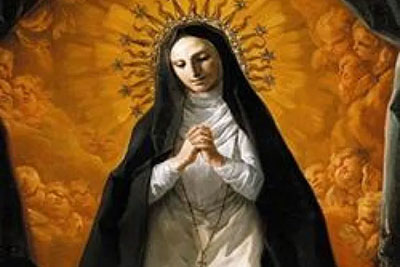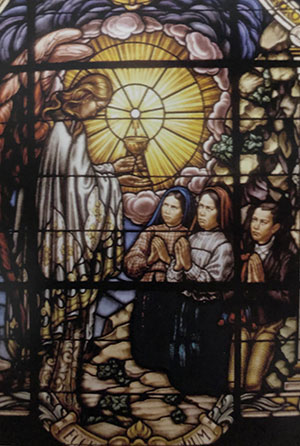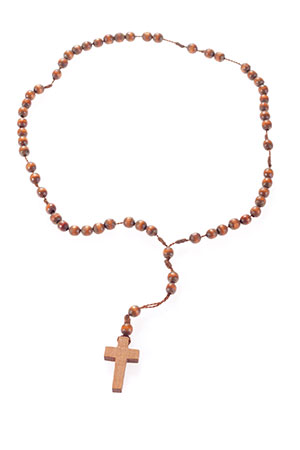 On Oct. 16, Roman Catholics celebrate the life of St. Margaret Mary Alacoque, the French nun whose visions of Christ helped to spread devotion to the Sacred Heart throughout the Western Church.
On Oct. 16, Roman Catholics celebrate the life of St. Margaret Mary Alacoque, the French nun whose visions of Christ helped to spread devotion to the Sacred Heart throughout the Western Church.
Margaret Mary Alacoque was born in July of 1647. Her parents Claude and Philiberte lived modest but virtuous lives, while Margaret showed herself to be a serious child with a focus on God. Claude died when Margaret was 8, and she suffered a paralyzing illness from the ages of 9 to 13. A struggle over her family's property made life difficult for Margaret and her mother for several years.
During her illness, Margaret made a vow to enter religious life. During adolescence, however, she changed her mind. For a period of time she lived a relatively ordinary life, enjoying the ordinary social functions of her day and considering the possibility of marriage.
Her life changed in response to a vision she saw one night while returning from a dance, in which she saw Christ being scourged. Margaret believed she had betrayed Jesus, by pursuing the pleasures of the world rather than her religious vocation. At age 22, she decided to enter a convent.
Two days after Christmas of 1673, Margaret experienced Christ's presence in an extraordinary way while in prayer. She heard Christ explain that he desired to show his love for the human race in a special way, by encouraging devotion to "the heart that so loved mankind."
She experienced a subsequent series of private revelations regarding the gratitude due to Jesus on the part of humanity, and the means of responding through public and private devotion. But the superior of the convent she dismissed this as a delusion.
This dismissal was a crushing disappointment, affecting the nun's health so seriously that she nearly died. In 1674, however, the Jesuit priest Father Claude de la Colombiere became Margaret's spiritual director. He believed her testimony, and chronicled it in writing.
Father de la Colombiere – later canonized as a saint – left the monastery to serve as a missionary in England. By the time he returned and died in 1681, Margaret had made peace with the apparent rejection of her experiences. Through St. Claude's direction, she had reached a point of inner peace, no longer concerned with the hostility of others in her community.
In time, however, many who doubted her would become convinced as they pondered what St. Claude had written about the Sacred Heart. Eventually, her own writings and the accounts of her would face a rigorous examination by Church officials.
By the time that occurred, however, St. Margaret Mary Alacoque had already gained what she desired: "To lose myself in the heart of Jesus." She faced her last illness with courage, frequently praying the words of Psalm 73: "What have I in heaven, and what do I desire on earth, but Thee alone, O my God?"
She died on Oct. 17, 1690, and was canonized by Pope Benedict XV in 1920.
— Catholic News Agency
 In 1916, the Angel of Peace appeared in Fatima, Portugal, to three shepherd children – Francisco, Jacinta and Lucia – teaching them the prayers that became the foundation for this Chaplet of Adoration and Reparation. As knowledge of Fatima spread, people began to say those prayers using a rosary. To encourage Eucharistic Adoration, Bishop Peter J. Jugis gave the chaplet his imprimatur in 2004.
In 1916, the Angel of Peace appeared in Fatima, Portugal, to three shepherd children – Francisco, Jacinta and Lucia – teaching them the prayers that became the foundation for this Chaplet of Adoration and Reparation. As knowledge of Fatima spread, people began to say those prayers using a rosary. To encourage Eucharistic Adoration, Bishop Peter J. Jugis gave the chaplet his imprimatur in 2004.
Using a rosary, you can pray this chaplet anytime, anywhere – an especially good devotion to practice in October, which is the month of the rosary, and for the feast of Our Lady of Fatima on Oct. 13.
Using the Prayers Taught by the Angel of Peace at Fatima, Portugal
Please pray this chaplet as often as you can -- anytime, anywhere -- especially at times and places where our Holy Triune God is most offended and unloved. (for public and private recitation on ordinary rosary beads)
Begin with:
Making the Sign of the Cross
(Kiss the Crucifix.)
Apostle’s Creed
(on the first bead and next three small beads:)
For the increase of Faith, Hope, and
Charity and the intentions of the Holy Father
1 Our Father / 3 Hail Marys / 1 Glory Be
(on the large bead before each decade:)
Most Holy Trinity, Father, Son, and Holy Spirit,
I adore you profoundly, and I
offer You the Most Precious Body, Blood,
Soul and Divinity of Jesus Christ,
present in all the tabernacles of the
world, in reparation for the outrages,
sacrileges, and indifference by which
He is offended, and by the infinite
merits of His Most Sacred Heart and
through the Immaculate Heart of Mary,
I beg the conversion of poor sinners.
(on the ten small beads of each decade:)
My God, I believe, I adore, I hope and I love You!
I ask pardon for those who do not believe,
do not adore, do not hope and do not love You.
(following the ten small beads of each decade:)
1 Glory Be
(and)
“O Most Holy Trinity, I adore You!
My God, My God, I love You in the most
Blessed Sacrament.”
(end Chaplet with Hail Holy Queen Prayer:)
Hail Holy Queen
Hail, Holy Queen, Mother of Mercy!
Our Life, our sweetness, and our Hope!
To Thee do we cry, poor banished children of Eve.
To Thee do we send up our sighs, mourning,
and weeping in this valley of tears.
Turn then, most gracious advocate,
thine eyes of mercy toward us;
and after this our exile show unto us the
blessed fruit of thy womb, Jesus.
O clement, O loving, O sweet Virgin Mary.
Pray for us O Holy Mother of God
That we may be made worthy of the promises of Christ. Amen
(Make the sign of the Cross)
In 1916, the Angel of Peace appeared in Fatima, Portugal,
to three shepherd children, Francisco, Jacinta, and Lucia
teaching them the prayers that became the foundation
for this Chaplet of Adoration and Reparation.

